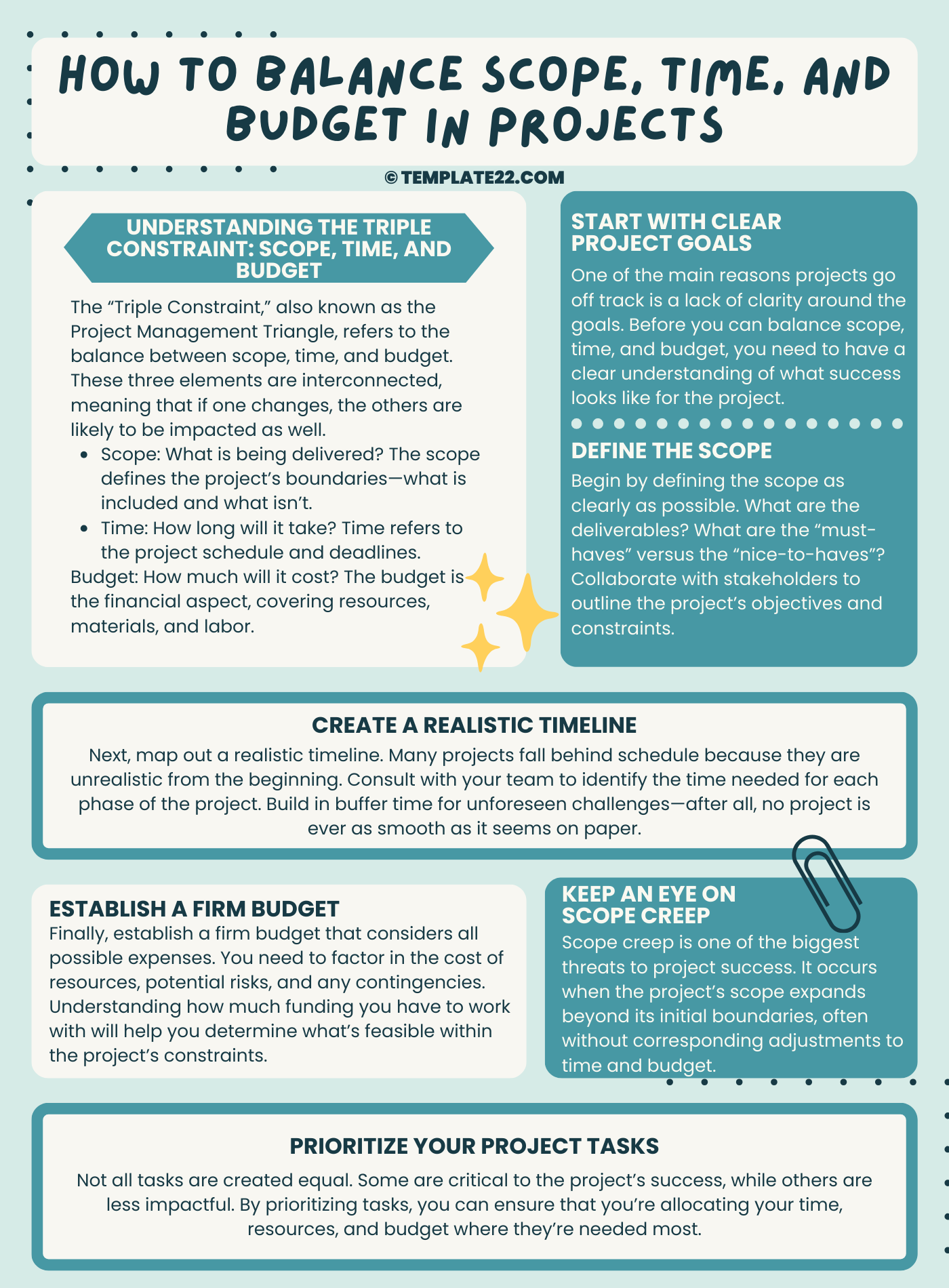 Balancing scope, time, and budget in a project is like walking a tightrope within the Project Management Triangle. You have to manage expectations, handle constraints, and ensure everyone involved is on the same page—all without tipping too far in one direction. Whether you’re a seasoned project manager or just starting, mastering this balancing act is crucial for delivering successful projects.
Balancing scope, time, and budget in a project is like walking a tightrope within the Project Management Triangle. You have to manage expectations, handle constraints, and ensure everyone involved is on the same page—all without tipping too far in one direction. Whether you’re a seasoned project manager or just starting, mastering this balancing act is crucial for delivering successful projects.
In this blog, we’ll dive into practical strategies to help you keep scope, time, and budget aligned while maintaining a sense of calm in the chaotic world of project management.
Understanding the Triple Constraint: Scope, Time, and Budget
The “Triple Constraint,” also known as the Project Management Triangle, refers to the balance between scope, time, and budget. These three elements are interconnected, meaning that if one changes, the others are likely to be impacted as well.
- Scope: What is being delivered? The scope defines the project’s boundaries—what is included and what isn’t.
- Time: How long will it take? Time refers to the project schedule and deadlines.
- Budget: How much will it cost? The budget is the financial aspect, covering resources, materials, and labor.
If you alter one side of the triangle, say by increasing the scope, you’re likely to need more time and money. Understanding this connection helps set a solid foundation for balancing these elements.
Start with Clear Project Goals
One of the main reasons projects go off track is a lack of clarity around the goals. Before you can balance scope, time, and budget, you need to have a clear understanding of what success looks like for the project.
Define the Scope
Begin by defining the scope as clearly as possible. What are the deliverables? What are the “must-haves” versus the “nice-to-haves”? Collaborate with stakeholders to outline the project’s objectives and constraints. By establishing a well-defined scope from the start, you set the guardrails for the project and reduce the likelihood of scope creep.
CLICK HERE TO DOWNLOAD 300+ PROJECT MANAGEMENT TEMPLATES & DOCUMENTS IN EXCEL
Create a Realistic Timeline
Next, map out a realistic timeline. Many projects fall behind schedule because they are unrealistic from the beginning. Consult with your team to identify the time needed for each phase of the project. Build in buffer time for unforeseen challenges—after all, no project is ever as smooth as it seems on paper.
Establish a Firm Budget
Finally, establish a firm budget that considers all possible expenses. You need to factor in the cost of resources, potential risks, and any contingencies. Understanding how much funding you have to work with will help you determine what’s feasible within the project’s constraints.
Keep an Eye on Scope Creep
Scope creep is one of the biggest threats to project success. It occurs when the project’s scope expands beyond its initial boundaries, often without corresponding adjustments to time and budget.
To manage scope creep effectively:
- Communicate clearly with stakeholders about what’s in and out of scope.
- Document changes and their impact on the project.
- Evaluate trade-offs before agreeing to scope changes. For example, if a new feature is added, how will it affect the schedule or budget?
Staying vigilant about scope creep within the Project Management Triangle will help you maintain control over the project and prevent surprises down the line.
Prioritize Your Project Tasks
Not all tasks are created equal. Some are critical to the project’s success, while others are less impactful. By prioritizing tasks, you can ensure that you’re allocating your time, resources, and budget where they’re needed most.
Use a Project Management Tool
A project management tool can help you prioritize tasks and monitor progress. Tools like Asana, Trello, or Microsoft Project allow you to visualize your timeline, assign tasks, and track the budget in real time.
Focus on the Critical Path
The critical path is the sequence of tasks that directly impact the project’s timeline. Focusing on these tasks helps ensure the project stays on track. By allocating more resources to critical path tasks, you can prevent delays and avoid time overruns.
Be Adaptable
Even the best-planned projects encounter unexpected obstacles. Whether it’s a delay in delivery, a new client request, or a change in resources, adaptability is key to balancing scope, time, and budget.
Embrace Agile Methodologies
Agile project management is built on adaptability. By breaking your project into smaller, manageable chunks called “sprints,” you can regularly reassess your progress and make adjustments as needed. Agile methodologies allow for more flexibility, which can help you quickly pivot when constraints shift.
CLICK HERE TO DOWNLOAD 300+ PROJECT MANAGEMENT TEMPLATES & DOCUMENTS IN EXCEL
Communicate Changes Early
When changes do arise, communicate them to all stakeholders as early as possible. This includes how changes will affect the scope, timeline, or budget. Transparency helps set expectations and ensures everyone understands the impact of the change.
Regularly Monitor and Adjust
Balancing scope, time, and budget isn’t a one-time effort—it requires ongoing attention. Throughout the project, make sure you’re regularly reviewing progress and making adjustments as necessary.
Set Up Checkpoints
Establish regular checkpoints during the project to review the status of the scope, time, and budget. These reviews can help identify potential issues before they become larger problems. Checkpoints also provide an opportunity to celebrate milestones, keeping the team motivated.
Use Metrics to Measure Progress
Key performance indicators (KPIs) such as burn rate (how quickly you’re spending your budget) or schedule variance (how far ahead or behind you are) offer valuable insights into the project’s health. By tracking these metrics, you can take corrective action when needed.
Conclusion
Balancing scope, time, and budget in projects is a dynamic process that requires careful planning, continuous monitoring, and, above all, flexibility. By setting clear goals, staying vigilant about scope creep, prioritizing tasks, and being adaptable, you can successfully navigate the challenges of project management.
Remember that in Project Management Triangle, achieving balance is not about perfection—it’s about making informed trade-offs and keeping the project on track toward its ultimate goal.
